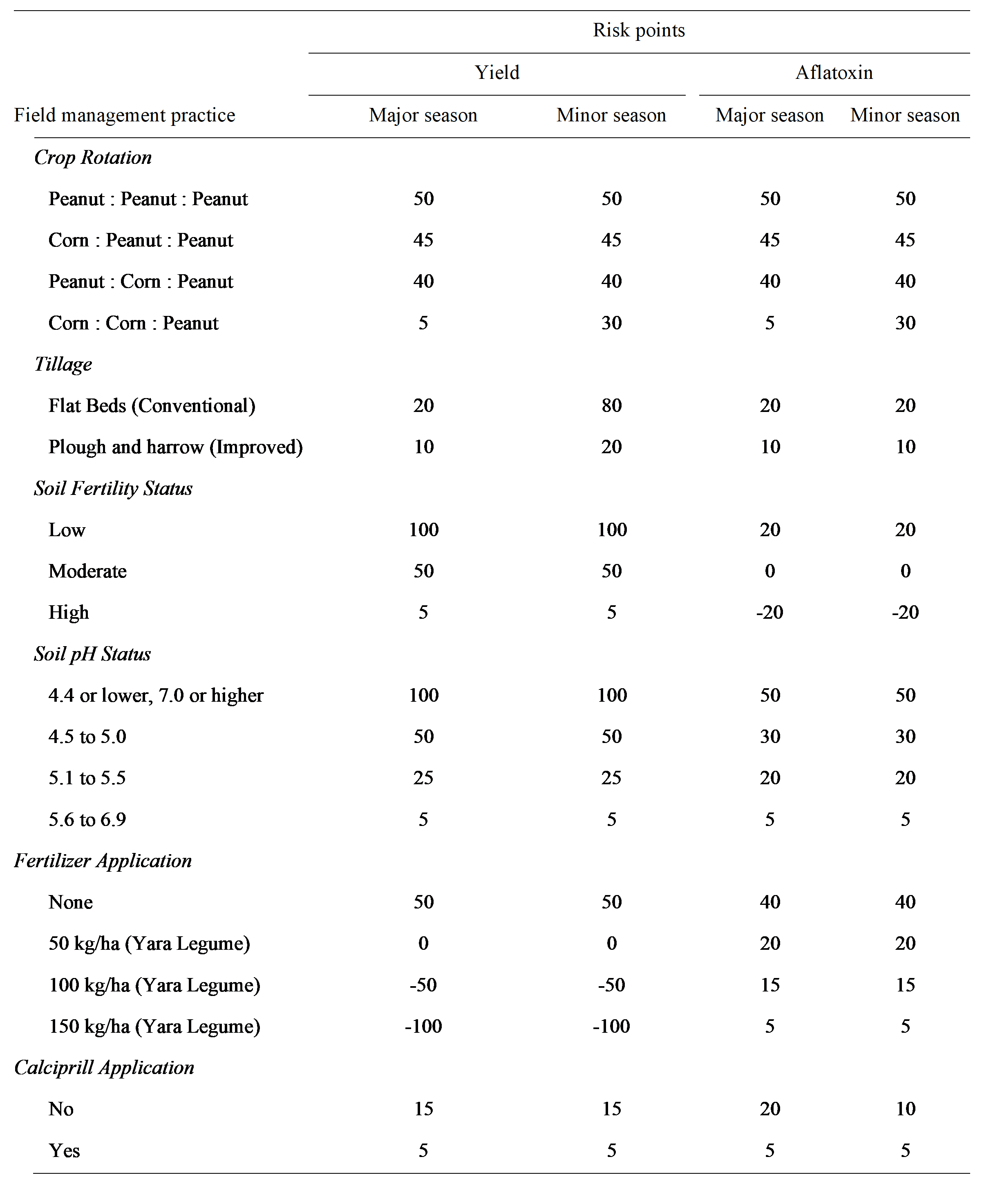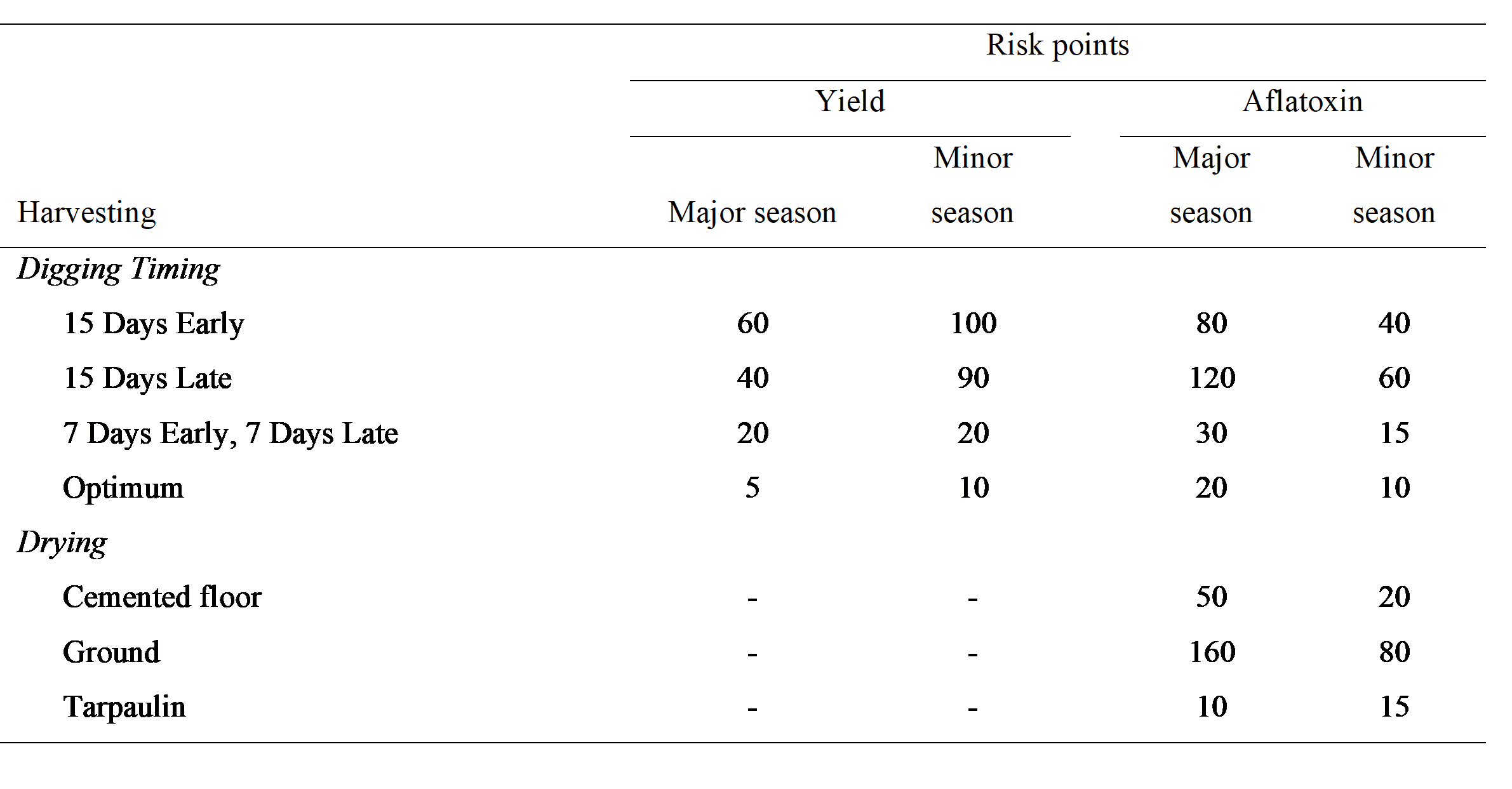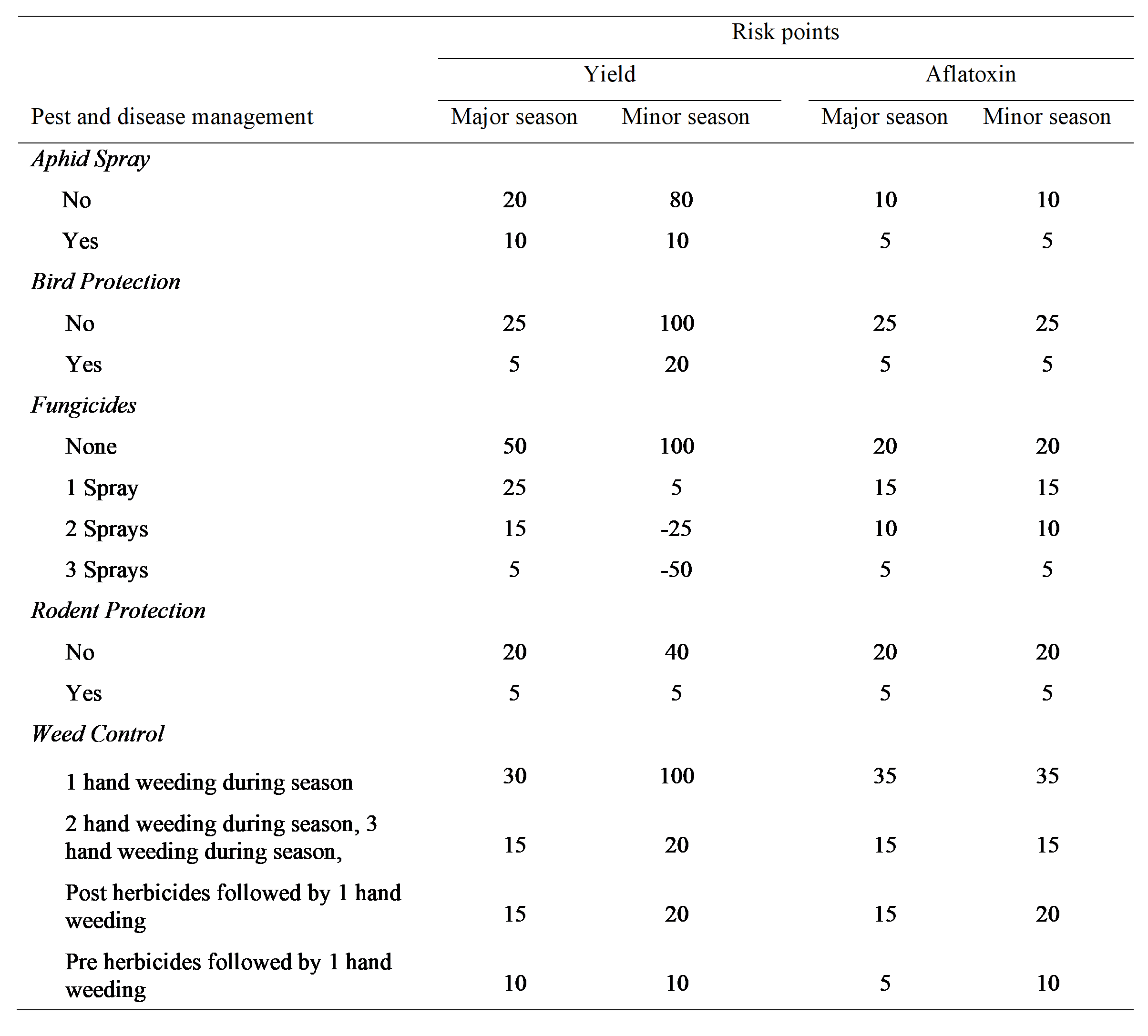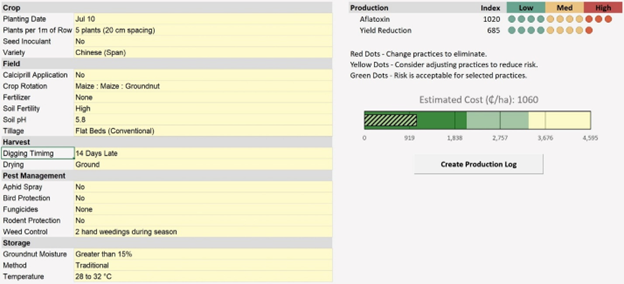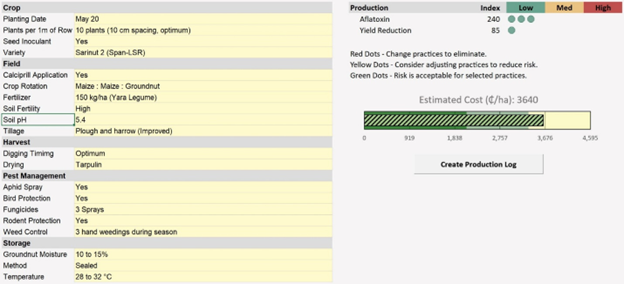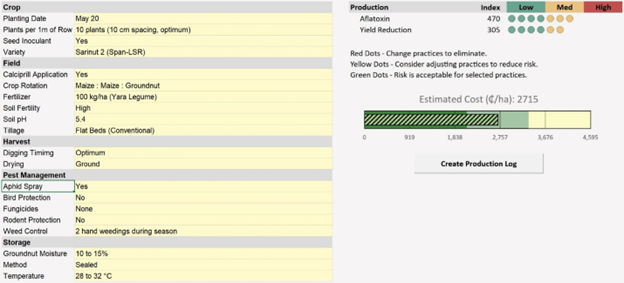Introduction
Cultivated peanut (Arachis hypogaea L.) is an important oil, food, and feed crop worldwide. In 2020, 53.64 million metric tons of peanut were produced on 31.57 million hectares worldwide (FAOSTAT, 2022). Peanut is grown mostly in tropical regions with Asia and Africa accounting for over 90% of world production (FAOSTAT, 2022). In Ghana, peanut remains the most important grain legume in terms of area under cultivation and annual production. Ghana produced 521,000 metric tons in 2018 on 320,000 hectares placing the country fifth in Africa for peanut cultivation (SRID-MoFA, 2019). The bulk of Ghana peanut production occurs in the Guinea and Sudan Savannah agro-ecologies where more than 90% of farming households are estimated to farm approximately 0.5 ha (Tsigbey et al., 2003). For these households, peanut significantly contributes to their livelihoods as a cash crop and relatively inexpensive highly nutritious food (Asibuo et al., 2008; Janila et al., 2013; Kleih et al., 2020).
Economically, Ghana peanut production is considered profitable with all the value chain actors reporting a net positive operating profit (Kleih et al., 2020). In 2018, peanut contributed 4.3% of the agricultural sector GDP which translated to 0.7% of the Ghana national GDP (Kleih et al., 2020). Despite its importance, Ghana peanut yields are often low in part to the negative impacts of arthropods, diseases, nematodes, and weeds (Abudulai et al., 2007; Dzomeku et al., 2009; Nutsugah et al., 2007; Umeh et al., 2002; Walker et al., 2014). Yield losses can approach 70% in West Africa when effective management for pests is not achieved (Ajeigbe et al., 2014; Nutsugah et al., 2007; Shokes and Culbreath, 1997; Subrahmaniyan et al., 2002; Waliyar et al., 2000). Monocotyledonous weeds including annual and perennial grasses and sedges as well as dicotyledonous weeds are prevalent in peanuts and can cause yield loss of between 50% and 80% in West Africa (Akobundu, 1987; Dzomeku et al., 2009). Peanut is very susceptible to early season weed interference because of their slow initial growth characteristics that allow many weed species to grow above the peanut canopy (Akobundu, 1987: Subrahmaniyan et al., 2002). Other important limitations in peanut cultivation are the effects of prolonged droughts, soil fertility management, pre-and post-harvest factors that predispose the crop to mycotoxins, limited access to improved cultivars, and wide plant spacings which affects optimum plant population (Naab et al., 2004 2005; Njorogae, 2018; Sugri et al., 2017).
Peanut is grown in all the agro-ecologies of Ghana except the Evergreen Forest and Coastal Savanna Zone. However, over 90% of cultivation is concentrated in the northern region of the country which is primarily the drier areas with Savanna and transitional-Savanna conditions. Rainfall in the Savanna agroecology is unimodal and usually begins in April or early May and ends in October with total precipitation between 900 to 1,100 mm, followed by a dry season. Land in this area is generally flat with some low-lying areas. Soils are shallow with low fertility, especially nitrogen (N) and organic matter. In contrast, annual rainfall of up to 1,300 mm has been recorded in the transitional zone and the area has a bi-modal rainfall pattern. Soils in this zone are deep and have higher fertility.
In southern Ghana, there is a bi-modal rainy season: April through June (i.e., major season) and September through November (minor season). The highest amount of rainfall is recorded in June. Generally, regions in southern Ghana experience high amounts of rainfall ranging from 1,400 to 1,600 mm annually. However, areas such as the eastern parts of Lake Volta and southwestern parts of Kumasi receive rainfall up to 2,000 mm every year. Soils in the forest zone are deep, easily tilled and offer very little restrictions to root growth. Soils are low in total N, low plant available phosphorus (P), and are acidic (pH 5.2-6.0).
Improved technologies for peanut production have been tested in Ghana for increased yield, which are suitable for many agricultural production areas in West Africa (Agbetiameh et al., 2020, Abudulai et al., 2018 2020; Ortega-Beltran and Bandyopadhyay, 2021). These technologies when applied have increased peanut yield in Ghana and most parts of West Africa and have increased financial returns and food security. These include: i) release of elite high yielding and early maturity peanut cultivars ii) development of Rhizobium inoculant specific for biological nitrogen fixation in peanut; iii) development of good agronomic practices such as planting time, plant spacing, crop rotation, and fertilizer dose to maximize yield; iv) development of integrated management of arthropods, nematodes, pathogens, and weeds to maximize yield; v) development special fertilizer formulations suitable for legume production; and vi) validation of technologies on good harvesting, drying, storage, shelling, and processing practices to reduce postharvest losses and risk of aflatoxin contamination. More recently, the biological control agent marketed as Aflasafe® (Anonymous, 2023a) has become available in Ghana and other countries in sub-Saharan Africa to reduce aflatoxin contamination in corn (Zea mays L.), peanut, and sorghum (Sorghun bicolor Moench.) (Agbetiameh et al., 2020; Senghor et al., 2020 2021). Atoxigenic strains of Aspergillus flavus are present in Aflasafe® that effectively compete with native strains that produce the toxin (Agbetiameh et al., 2020; Senghor et al., 2020 2021). However, this approach to aflatoxin mitigation has limited commercial acceptance in peanut. Collectively, these technologies and related information are often discussed in isolation of one another, and are presented in separate extension materials/media such as peer-reviewed publications, extension guides and manual, conference proceedings, or media forms such as radio.
To date, dissemination of these technologies has largely been carried out and promoted via on-farm demonstrations, farmer field schools, face-to-face trainings, and formal meetings. A major challenge with these extension approaches is limited interaction. One example of an approach to characterizing and disseminating information on complex interactions of production and pest management practices is the Peanut Rx tool developed for peanut in the southeastern US (Anonymous, 2022). This tool is designed to assist farmers and their advisors in characterizing risk of tomato spotted wilt (tospovirus, Bunyaviridae) transmitted by thrips (Frankliniella fusca Pergande, F. occidentalis Hinds) and other economically-important pathogens in peanut using combinations of variety selection, cultural practices, and pesticides. A point system was developed based on empirical data and expert opinion to characterize risk. The risk tool is modified on a frequent basis as new cultivars are released and when new knowledge on effectiveness of production and pest management practices become available. In this paper, we illustrate how a MS Excel based peanut risk management tool was developed for use by extension service providers in Ghana to advise farmers on recommended production practices that can be combined to minimize risk to yield reduction and aflatoxin contamination at an affordable cost. The tool was developed for peanut production areas in northern and southern Ghana and was adapted from a similar tool created for peanut farmers in North Carolina (USA) and other countries (Jordan et al., 2020; Jordan et al., 2022a 2022b). The latest version of the tool can be accessed at: https://cropmanagement.cals.ncsu.edu/risk-tools/peanut.html. Similar to the Peanut Rx platform, this tool is not static and will be modified by experts over time based on release of improved varieties and information from both empirical and observational data relative to new practices or refinement of current practices.
Development of a Peanut Risk Management Tool for Ghana
Subject matter experts (SMEs) meeting
A panel of 20 Subject Matter Experts (SMEs) from research institutions and academia in Ghana discussed and assigned risk indices to key peanut production practices, beginning from site selection through storage. The SMEs comprised scientists with expertise in agronomy, entomology, plant pathology, weed science, soil science, postharvest technology, genetics and plant breeding, seed science, food science, agribusiness and agricultural economics. Risk indices were assigned for each production practice based on consensus among experts.
Preliminary meeting to identify and rank risk factors in peanut cultivation
A workshop was organized at CSIR – Savanna Agricultural Research Institute, Nyankpala, Ghana to identify the major practices in peanut production that affect yield and aflatoxin contamination levels in northern and southern Ghana. These practices were identified based on data gathered from peer-reviewed journal papers on peanut cultivation in Ghana, technical reports, undergraduate and graduate students’ theses, peanut production manuals and extension leaflets. These practices were grouped into four categories for their effect on yield reduction. Categories included
- 1
Crop Practices (e.g., planting date, plant density, rhizobium inoculation of seed, cultivar);
- 2
Field Practices (e.g., application of Calciprill or gypsum, crop rotation, fertilizer application, soil fertility status, soil pH, tillage practice);
- 3
Harvesting (e.g., digging time, drying practices); and
- 4
Pest management practices (e.g., aphid spray, bird protection, fungicides application, rodent protection, weed control).
For aflatoxin contamination, a fifth category (e.g., storage) was added to those identified for yield reduction.
After identifying key practices, risk indices were developed for each practice based on data from peer-reviewed publications or expert opinions (where published reports were non-existent). The higher the score the greater the risk. Scores were assigned by first identifying the best and recommended method/time for an activity and assigning the lowest risk score. For northern Ghana, a minimum risk score of 5 was used for most practices, except for planting date (10 points), tillage (10 points), and fertilizer application (50 points). It should be noted that all practices, including the best, have some level of risk associated with them. Afterward, the worst practices were identified and assigned the highest risk scores. The highest risk score for northern Ghana was 160 points. Intermediate practices were also assigned risk scores based on their effects on yield or aflatoxin contamination using published data or expert opinion.
For southern Ghana, two risk tools were developed because of the two cropping seasons in that area. For the major season (April-June), risk scores ranged between -10 (minimum) and 100 (maximum) for all practices. The risk scores for the minor season (September-November) ranged between -100 (minimum) and 160 (maximum). Again, scores for recommended practices were lowest while those for poor practices were highest and varied depending on their extents of deviation from the recommended.
Scoring of risk values
At the workshop, the SMEs were divided into two groups to work on the risk management tools for northern and southern Ghana. In these sub-groups, each practice was assigned a separate risk score by the experts present and the means of the scores for each practice were inserted into an MS Excel template. This template was programmed to produce an interface that uses dots and color schemes to pictorially illustrate to users how the combination of production practices contributes to potential yield reductions and aflatoxin contamination.
The impact of production and pest management practices that affect peanut yield in a positive manner will in many cases improve aflatoxin mitigation (Abudulai et al., 2020; Appaw et al., 2020; Waliyar et al., 2008). However, there are instances when approaches to optimizing peanut yield are not correlated with reductions in aflatoxin mitigation (Abudulai et al., 2020; Appaw et al., 2020; Waliyar et al., 2008). We discuss risks to peanut yield and contamination by aflatoxin in separate sections in this paper.
Scores are based on empirical data sets and observational but are not directly related to these data. This risk tool, like Peanut Rx (Anonymous, 2020) and the NC Peanut Risk Tool (Jordan et al., 2022), does not guarantee a positive response to yield or aflatoxin reduction if a set of practices is implemented. The tool does, however, indicate that a set of practices has the potential to protect yield and minimize aflatoxin contamination under typical conditions during a cropping cycle, drying, and storage.
It is important to note that this is the first attempt to merge information from empirical studies and observations from researchers and practitioners into a comprehensive risk management tool. Gaps in empirical data that would be useful in developing the tool do exist, and in those cases, expert opinion and consensus from co-authors were used. From a scientific standpoint, this is not considered ideal, but was the best option for initial tool development. Empirical data are used when available and we point out when observational and/or expert opinion are used as the only source of information. Over time, the goal is to reconsider each element of the tool, especially with respect to recent findings in the literature. For example, when Aflasafe® becomes more readily available, its impact on aflatoxin mitigation will be incorporated into the risk tool. The current tool has been important in informing researchers on what topics need to be addressed to find solutions for limitations to yield and aflatoxin mitigation.
Computation of overall risk score
After the initial Excel spreadsheet was developed identifying practices that influence peanut yield and aflatoxin contamination, a small group of researchers evaluated the associated risk scores for each practice as they related to the overall risk score for each risk factor, yield loss and aflatoxin contamination. This step in the process was driven by expert opinion and consensus. This group of researchers participated in open and frank discussions about both the range of scores across major practices and scores within each practice. For each risk factor, an overall risk score was calculated by summing all the practice risk scores for that factor based on the set of selected practices. Two sets of practices defined the minimum and maximum overall risk scores for a risk factor. The minimum overall risk score was the sum of risk scores when implementing all the best/recommended practices (e.g., practices with lowest risk scores). The maximum overall risk score was the sum of risk scores when implementing all of the least effective practices (e.g., practices with highest risk scores). Once the minimum and maximum overall risk scores were defined, overall risk score thresholds identifying moderate risk and high risk were established. These thresholds were set based on expert opinion and data from various trials looking at production scenarios. With the moderate and high-risk thresholds established, three risk categories based on the overall risk score were established. The first category identifies a selected set of practices as having an acceptable level of risk. This category had an overall risk value between the minimum overall risk value and moderate threshold and was indicated with green dots in the risk tool. The second category identifies a selected set of practices as having a moderate level of risk where consideration should be given to selecting better practices. This category has an overall risk value between the moderate and high thresholds and is indicated with yellow dots. The third category identifies a selected set of practices as having a high level of risk where selected practices need to be replaced with better practices. This category has an overall risk value between the high-risk threshold and the maximum overall risk score and was indicated with red dots. The computed overall risk scores for yield loss and aflatoxin contamination are used when evaluating risk associated with a selected set of practices. In use, the best sets of production practices have the lowest overall risk scores.
Post-workshop adjustments
After the workshop, discussions were held among experts from Ghana and North Carolina State University, Raleigh, USA to re-assess practices, adjusted scores, and review their overall impact on risk to yield reduction and aflatoxin. These assessments were compiled in July 2021 and they were based on further literature review and engagements with extension professionals and farmers. Afterward, a final review and approval of risk scores by all experts was undertaken virtually in August 2021.
Scoring of Yield Reduction and Aflatoxin Contamination Practices
Risks to yield
Crop management practices
Planting peanut soon after the onset of rains is reported to lead to increased biomass and pod yield, irrespective of the variety planted in Ghana (Naab et al., 2005). In general, the forecasted rainfall onset dates for the northern and transitional zone in Ghana is April and that of the southern zone is March of each year (Amekudzi et al., 2015; Gbangou et al., 2019). This information from historical data sets guided the selection of optimum planting dates for peanut production zones in northern and southern Ghana used in the risk tool. However, for early maturing varieties (e.g., Sarinut 2), the reduced effect of delayed planting on biomass and pod yield was factored into the calibration of the risk tool for northern Ghana. Seven planting date periods were identified and their effects on yield in northern Ghana were assigned risk scores (Table 1). It should be noted that some periods were assigned the same risk scores. Among the dates selected, planting peanut between May 15 and 31 was assigned the lowest score while planting after July 15 had the highest risk score. The risk scores for planting dates outside May 15 to 31 window but before June 30 were lower (below 30 points) while plantings occurring after July 1 or before April 30 had higher risk scores (above 80 points). For southern Ghana, three planting date periods were identified and their effects on yield reduction were scored for the minor season. Peanut planted between August 15 and 31 was assigned a low risk score of 35 points while those planted after September 15 had higher risk score. In the major season, six planting date periods were identified. The planting time with the lowest risk score was April 1-14 while peanut planted after May 15 had the highest risk score. The optimum planting time for peanut was March 15 – April 30 (Table 2).
The effect of plant population on yield reduction was assessed at 5 levels (e.g., broadcasting and planting in rows with plants spaced 10, 15, 20, and 25 cm apart for northern Ghana (Table 1). Planting at a 10-cm plant spacing had the lowest risk score of 5 points. Fields establishment by broadcasting were assigned the highest risk score of 160 (Table 1). In contrast, the effect of plant population on yield was assessed at three levels for both the minor and major seasons in southern Ghana. In both seasons, a plant spacing of 10 cm had the lowest risk scores while increasing the intra-row spacing to 20 cm was assigned the highest risk score. In general, the lowest and highest risk scores were 5 and 30 points, respectively for the major season while that of the minor season were 15 and 80 points, respectively (Table 2). These risk scores for spacing were selected based on research conducted in Ghana and elsewhere showing yield components (e.g., number and weight of pods per plant) increases with increasing plant density (Abdul Rahman et al., 2020; Bihter et al., 2016; Kombiok, 2013; Konlan et al., 2013). Plant density can be increased by either reducing the intra row spacing up to 10cm (Bihter et al., 2016) or reducing the inter row spacing up to 35 cm (Kombiok, 2013).
In both northern and southern Ghana, the effect of rhizobium inoculant was assessed at two levels (e.g., present or absent). The use of rhizobium inoculant was assigned the lowest score while the highest score was assigned to the absence of rhizobium inoculant (Tables 1 and 2). Low soil fertility and continuous cropping limit peanut yields on farmers’ fields. To mitigate this challenge, the use of the plant systems’ internal resources such as biological nitrogen fixation (BNF) has been identified as an efficient method of enhancing the crop productivity (Asante et al., 2020). Studies conducted in Ghana indicate that the use of rhizobium inoculants (Bradyrhizobium yuanmingense) significantly increases yield. Combining rhizobium inoculants with phosphprus (P) fertilizers further increases yields (Asante et al., 2020; Mintah et al., 2020; Naabe et al., 2021).
Five improved peanut varieties and a local variety (Shitouqui) were selected and incorporated into the northern Ghana risk tool. The highest risk score of 70 points was assigned to Shitouqui (a pest and disease susceptible variety) while cultivars resistant to leaf spot (LSR) and groundnut rosette diseases (GRDR) were assigned the lowest score (Table 1). In southern Ghana, three improved peanut varieties which are mostly cultivated in the minor season were scored. The variety Yenyawoso (GRD resistant) was assigned the lowest score while Shitouqui and Konkoma (disease susceptible varieties) had the highest risk for yield reduction. For the major season, six improved peanut varieties were scored for their risk to yield reductions. Of these, Obolo (a leaf spot resistant variety) and Otuhia (leaf spot and peanut rosette disease resistant) were assigned the lowest score (e.g., 5 points) while Shitouqui and Konkoma (disease susceptible varieties) were assigned the highest risk score (e.g., 50 points) (Table 2). These improved varieties were scored based on their susceptibility to key biotic stresses in peanut production (e.g., aphids and leaf spot and rosette diseases). This was because the seed (variety) used for production will determine the yield that will be obtained at the end of the season (Ajeigbe et al., 2015).
Field management practices
Field management practices such as crop rotation, fertilizer application, calciprill (37% Ca; 0.6% Mg; 52%; 2 – 6 mm granule size; 1.2 kg/l bulk density; Distributed by Demeter Ghana Ltd., Labone, Accra) application, field soil fertility status, and tillage practices were scored for their risk to yield reduction. Planting peanut after a cereal crop (corn, sorghum) was assigned the lowest score, while the highest was assigned to continuous cropping of peanut for both northern and southern Ghana (Tables 3 and 4). Continuously cropping peanut can lead to nutrient depletion, growth inhibition, and yield decline because of changes in soil microbial structure and potential functions as well as increases in the relative abundance of pathogenic microorganisms such as Fusarium and Athelia (Chen et al., 2012, 2014; Li et al., 2022). In contrast, rotating peanut with other crops reduces the potential of soil-borne pathogens, thus increasing the peanut yield and quality (Li et al., 2022). The lowest scores were assigned to rotation schemes that had peanut planted after two consecutive cereal seasons.
The 250 kg/ha fertilizer rate (0% N, 18% P2O5, 13% K2O, 29% CaO) (Yara Legume Fertilizer, Accra, Ghana) was assigned the lowest risk score, while not applying fertilizer was given the highest score in northern Ghana. In general, a decrease in fertilizer application from 250 kg/ha increased the risk score. Similary, the Calciprill application was assigned the lowest risk score while not applying it received the highest score (Table 3). For southern Ghana, three fertilizer rates and not applying fertilizer were scored. For both the minor and major season, the lowest risk points were assigned to 150 kg/ha Yara legume and the highest to not applying fertilizer. For Calciprill, including an application was assigned the lowest risk score while not using Calciprill had the highest risk score in both cropping seasons (Table 4). Many studies indicate that peanut responds positively to high P fertilizers and lower amounts of N and potassium (K); only low starter doses of N may be needed to stimulate initial plant growth before nodule formation (Basu et al., 2008; Hossain and Hamid, 2007). Hence, lower risk scores were assigned as fertilizer rate increased. Using Calciprill in peanut production is confirmed to improve peanut growth and yield (Adhikari et al., 2003; Wiatrak et al., 2006; Yadav et al., 2015).
In northern Ghana, risk was assigned to three soil fertility levels; low, moderate, and high. The highest risk score was assigned to low fertility soils while the lowest score was assigned to fields with high fertility status. Soil with 5.6 to 6.9 pH were given the lowest risk score of 5 points while those with pH less than 4.4 or greater than 7.0 were assigned the highest risk scores of 100 points. Risk points for tillage were low for ploughed and harrowed fields and high for those planted on flat beds (Table 3). For the minor and major season in southern Ghana, the lowest risk to yield reduction was assigned to high soil fertility and the highest to low fertility status fields. Fields with soil pH of 5.6 to 6.9 were assigned the lowest score while those with pH less than 4.4 or greater than 7.0 were assigned the highest. Two tillage methods (flat beds and ploughing and harrowing) were assessed risk to yield reduction. Risk scores were highest for flat beds (i.e., unploughed fields) and lowest for ploughing and harrowing fields, in both minor and major seasons (Table 4).
Generally, peanut grows best in deep well-drained sandy loam or in sandy clay loam soils with pH from 6.5-7.0 and high fertility (Ajeigbea et al., 2015). Low soil pH reduces growth, nutrient absorption, nodulation, and yield. It is also associated with aluminum (Al) and manganese (Mn) toxicities as well as deficiencies of calcium (Ca), magnesium (Mg), molybdenum (Mo), and P deficiencies (Van Rossum et al., 1994). Based on literature available on the effects of low soil fertility and pH on peanut yield, higher risk scores were assigned to poor, acidic, or alkaline soils.
Harvest
In northern Ghana, the risk to yield reduction relative to digging timing was scored for farmers who harvest before, at, and after the time of the optimum digging (maturity). The risk score was lowest for digging at the optimum time (5 points) and highest for digging 21 days earlier (100 points). Risk scores for farmers who delayed digging by 21 days was also high (70 points) (Table 5). In the south, the lowest score was assigned to digging at the optimum time while digging 15 days late (for minor season) or 15 days early (for major season) was assigned the highest risk score. Digging 7 days early or late from optimal also increased the risk to yield reduction (Table 6). The effect of digging time on peanut yield varies with the cultivar (Knauft et al., 1986; (Oakes et al., 2020). Decreases in yield due to delayed digging are often attributed to foliar diseases such as leaf spot (Anco et al., 2020). For the risk management tool, digging earlier than physiological maturity was assigned higher yield reduction risk scores because of the reduced quantity of mature pods. Similarly, delayed digging was assigned higher risk scores because some pods might remain in the soil or sprout, thus affecting the peanut quantity.
Farmers in Ghana use several approaches to determine when to dig peanut. In some instances, farmers dig peanut when plants begin defoliation, most often due to leaf spot disease (Asiedu et al., 2014). In other instances, farmers shell pods to determine kernel maturity (Asiedu et al., 2014). Their decision is also based on availability of labor to dig and remove pods from plants. In the risk tool, optimum maturity is based on pod mesocarp color which can be determined using the shell out method or scraping pods with a knife. One goal of extension professionals in Ghana is to inform more farmers on how to determine optimum maturity for harvest.
Pest management
Aphids (Aphis craccivora Kock), birds, early leaf spot [caused by Passalora arachidicola (Hori) U. Braun 1999 (syn. Cercospora arachidicola Hori 1917], late leaf spot [caused by Nothopassalora personata (Berk. & M. A. Curtis) U. Braun, C. Nakash, Videira & Crous 2017 (syn. Cercosporidium personatum (Berk. & Curt.) Deighton 1967], rodents, and weeds were the pests considered under this category. A risk score of 5 was assigned for peanuts protected from aphid while 80 points was assigned for unprotected in northern Ghana (Table 7). Similar values were used for the two southern Ghanaseasons . (Table 8). Aphid infestation threatens profitable peanut production in all Ghana production zones. Aphid populations in peanut fields is influenced by intra-plant spacings with closer spacings reported to reduce infestation levels and vice versa (A’Brook. 1968; Farrell, 1976). Increases in aphid populations are also impacted by abiotic factors (Jasrotia et al., 2016). The pest consequently affects peanut yields by transmitting peanut rosette disease virus (Javed et al., 2014; Naidu et al., 1999). The disease is endemic to peanut growing areas of Sub-Saharan Africa and it causes annual yield loss worth over US$150 million (Naidu et al., 1999). Protecting peanut from aphids mitigates yield losses and was therefore assigned the lowest risk score while not controlling aphids was assigned a higher risk score.
For birds, the lowest risk score was assigned to protected peanut while unprotected was assigned the highest risk score in the tools developed for northern and southern Ghana (Tables 7 and 8). Crop depredation by birds is a serious problem in the cultivation of sorghum, rice (Oryza sativa L.), millet [Eleusine coracana (L.) Gaertn], and peanut although the magnitude of yield loss is unknown (Kale et al., 2012, 2014; Soundararajan et al., 2021). Many scaring methods are used to reduce bird damage and loss (Kale et al., 2014).
The risk management tools for northern and southern Ghana had low risk points for fields protected from leaf spot diseases by applying 3 fungicide sprays while the unprotected peanut had the highest score (Tables 7 and 8). The risk increased as the number fungicide sprays was reduced. Early leaf spot and late leaf spot diseases are estimated to cause annual peanut yield losses of approximately 19% in Africa (Babu et al., 1995). Culbreath et al. (2006) showed that full season application of fungicides to manage leaf spot diseases requires up to seven sprays. In the Ghana risk management tool, a maximum of three sprays were considered adequate to protect the crop from these diseases and was assigned the lowest risk score. This was based on field trials conducted in Ghana, Benin, and Niger that demonstrated two or three fungicide applications were enough to significantly increase pod yields (Arthur et al., 2022; Naab et al., 2005; Waliyar et al., 2000).
Farmers perceive rodents as a major pest and losses have been estimated at 13% (Brown et al., 2008). Risk scores for peanut protected from rodents were therefore low compared to the unprotected peanuts in the tools for the two production zones (e.g., north and south) (Tables 7 and 8). For rodent management, critical stages that require protection include germination, pod formation, and pod maturity (Butani et al., 2006).
Weed control and its effect on yield reduction was scored at different levels in the northern and southern Ghana risk management tools (Tables 7 and 8). The lowest score was assigned to applying preemergence herbicide followed by a single hand weeding while the highest score was assigned to single hand weeding during the season. Risk scores for other weed management practices and combinations were generally below 25 points for both locations. This was based on studies (Abudulai et al., 2018; Arthur et al., 2022; Dzomeku et al., 2019; Wilfred et al., 2020) that determined two hand weedings or applying pendimethalin preemergence herbicide followed by one hand weeding in peanut production results in low weed density and consequently increases yield. Risk scores were, however, higher for weedy fields. Weeding more than twice affects pegging since the third hand weeding interferes with the pegging. It is recommended that weeds should be pulled out by hand if peanut fields are weedy at pegging. Alternatively, selective herbicides can be used for weed control at that stage.
Aflatoxin contamination scores
Crop management practices
Unlike the US, Ghana does not have an effective regulatory process to restrict movement of aflatoxin-contaminated peanut into local markets. The range of risk in the Ghana risk tool does not reflect a value similar to thresholds for aflatoxin set by regulatory agencies in the US or European Union import restrictions (Anonymous, 2020 2023b). The range of risk is a relative assessment, and even though risk could be low as designated by the green category, risk to the consumer could still be relatively high.
Positive impacts of optimum variety selection, planting and harvest date, plant density, and contributions of effective pest management are well documented in the literature. However, not all practices have been evaluated in empirical studies in Ghana. Similarly, there are even fewer data sets in literature associated with aflatoxin mitigation. With this in mind, aflatoxin risk assessment in the current risk tool is primarily based on expert opinion and theoretical assumptions. Of course, this is not the desired approach given the importance of the scientific process and establishment of cause and effect criteria. None-the-less, the absence of this information, theory of what could possibly affect yield or aflatoxin is likely more effective than a vacuum of information. With this in mind, contributions of practices to plant health are considered approaches that could create an environment where Aspergillus flavus is less likely to increase. Research that refutes those assumptions in the risk tool would be valuable in future iterations of the risk tool.
The range of risk points for the effect of planting date on aflatoxin contamination ranged from 20 (May 15 – June 14) to 100 points (July 15 – July 31) for northern Ghana. The planting window, May 15 – June 14, was selected as the optimum for calculating risks to aflatoxin contamination. For southern Ghana, the lowest risk scores were assigned to April 1 and 14 plantings. The risk scores increased as the planting date was delayed. Similarly, risk scores increased when planting is earlier than the April 1 – 14 window (Tables 1 and 2). This approach to assigning points was because early planting could result in peanut reaching maturation and harvest prior to drought and high temperature that predisposes the crop to high aflatoxin contamination (Diao et al., 2015; Waliyar et al., 2003, 2008). These environmental stresses reduce physiological defense mechanisms that are used to resist the invasion of aflatoxigenic fungi (Cole et al., 1985).
Information in the peer-reviewed literature is limited with respect to assigning points associated with tillage, plant density, inoculation with rhizobium for biological nitrogen fixation (BNF), and applying fertilizer. In theory, a higher plant density could shade soil and minimize the likelihood that soils would experience high temperatures, especially later in the cropping cycle when soil moisture can be limiting. Plants with adequate biological nitrogen fixation (BNF) or fertilizer could have greater rates of plant growth and close the canopy more quickly than peanut without adequate fertility and create a soil environment that is less favorable for Aspergillus flavus. Plants with adequate nutrition may be able to prevent negative impacts of stress from both abiotic and biotic sources. Establishing and maintaining an adequate plant density in the field and rhizobium inoculant contribute to vigorous plant growth thereby enhancing the plant ability to minimize aflatoxigenic fungal infections (Guchi, 2015; Mkandawire et al., 2021); Nhamo et al., 2017; Waliyar et al., 2008).
For plant spacing, the lowest risk score was assigned to peanut planted at a spacing of 10 cm between plants and the highest risk score was assigned to those that were broadcasted in northern Ghana. In southern Ghana, a spacing of 10 cm between plants had the lowest risk score and risk scores increased with increased spacing. Also, the risk score for seeds treated with BNF inoculant was the lowest while non-inoculated seeds were assigned the highest score for both northern and southern Ghana (Tables 1 and 2).
The highest score for varieties was assigned to the use of local disease and pest susceptible varieties (Shitouqui), while planting improved varieties resistant to leaf spot and rosette diseases was assigned the lowest score (Tables 1 and 2). In Ghana, an A. flavus resistant variety (Crops Dehyee) was released for cultivation in the Savanna, transitional, and forest areas (GVRS, 2019) but its cultivation among farmers is low, thus a need for promotion of this variety. Increased research to develop resistant varieties using conventional and transgenic approaches is being explored globally (Walivar et al., 2008). Farmers can therefore use existing improved varieties together with the adoption of recommended crop management practices that reduce the risk of aflatoxins contamination as demonstrated in the risk management tool. While not documented, varieties that enable plants to withstand biotic stress due to pathogens may be more effective in tolerating infection by Aspergillus flavus. This assumption is open to question for these varieties and additional research is needed to support or refute this supposition.
Field management practices
The risk of aflatoxin contamination was scored for field management practices such as crop rotation, fertilizer application, soil fertility status and tillage. Continuously cropping peanut on the same piece of land, not applying fertilizer, planting on soils with low fertility, pH less than 4.4 or higher than 7.0, and planting on flat beds (e.g., without ploughing and harrowing) were assigned the highest score. In contrast, planting peanut on lands previously cropped to a cereal (maize or sorghum), application of at least 150 kg/ha of fertilizer, soils with high fertility, soil pH of 5.6 to 6.9, and planting on fields that are ploughed and harrowed were assigned the lowest risk scores. Risk scores increased as practices shifted away from recommended practices for peanut production (Tables 3 and 4). These scores reflect impact on plant health. As mentioned earlier with respect to varieties, there is a need to validate or refute this assumption.
Important field practices that influence aflatoxin levels include tillage, crop rotation, and fertilization (Bediako et al., 2019; Torres et al., 2014). Abbas et al. (2009) reported abundant propagules of A. flavus on the soil surface of no-till fields and that this enhances the potential for aflatoxin contamination compared to conventionally tilled soils. Ploughing and harrowing (i.e., conventional tillage practices) of fields contributes to minimizing aflatoxin contamination (Zablotowicz et al., 2007) and is recommended in peanut cultivation.
Continuous cropping of peanut on the same land leads to increases in the population of Aspergillus species consequently increasing their infection and aflatoxin contamination while rotating with non-host crops may lower the survival of different species/strains, thus minimizing aflatoxins in peanut (Ortiz et al., 2011). Abraham et al. (2016) identified cropping sequences in Malawi affected aflatoxin in peanut and the impact of peanut on aflatoxin in subsequent crops. Planting corn prior to peanut or peanut prior to corn increased aflatoxin contamination in the subsequent crop compared with cotton planted the year prior to peanut. Jaime-Garcia and Cotty (2010) reported that aflatoxin levels were greater when corn was the previous crop compared with cotton (Gossypium hirsutum L.) or grain sorghum. Also, poor soil fertility stresses peanut plants during seed development and this easily predisposes it to high aflatoxin levels (Diao et al., 2015; Torres et al., 2014). Soil application of gypsum or Calciprill contributes to a reduction in the pre-harvest A flavus infection and aflatoxin contamination in peanut (Guchi, 2015). Hence, adoption of recommendations for these production practices in peanut cultivation can result in 70-84% reductions in aflatoxin contamination (Waliyar et al., 2007).
Harvest
In northern Ghana, digging peanut at the optimum time (e.g., physiological maturity) and drying on tarpaulin were assigned the lowest risk scores. However, digging 21 days earlier or 21 days later and drying on the ground were assigned the highest score. The risk scores increased depending on the extent of deviation from the recommended practices (Table 5). In southern Ghana and for the minor and major season, digging peanut at the optimum time (e.g., physiological maturity), and drying on tarpaulin were assigned the lowest scores while delaying digging by 15 days and drying on the ground were assigned the highest risk to aflatoxin contamination. Harvesting earlier or later than the period of physiological maturity increased the risk to aflatoxin contamination (Table 6). Harvesting (digging) peanut at optimum maturity is key to reducing the numbers of over mature or very immature pods (Torres et al., 2014). Studies show that small immature kernels (e.g., early digging) and over-mature kernels (e.g., late digging) are likely to have higher aflatoxin levels than large and mature kernels obtained from promptly harvested peanut (Cole et al., 1985; Diao et al., 2015). This is because the immature peanuts lack the capacity to produce phytoalexins faster than mature ones, thus predisposing them to early contamination. The mature peanuts also have sustained resistance to A. flavus contamination after the phytoalexins production disappears (Diao et al., 2015). Thus, the low scores for digging at physiological maturity and higher scores for early or delayed digging. Zuza et al. (2018) in Mozambique reported that harvesting peanut 10 days before or after optimum maturity resulted in greater aflatoxin contamination compared with harvest at optimum maturity.
Pest management
For both northern and southern Ghana, pest management practices such as protection from aphids, birds, diseases, rodents and weeds were scored for their effect on aflatoxin contamination. Peanut protected from aphids, birds, diseases (e.g., three rounds of fungicide sprays), rodents, and weeds (e.g., preemergence herbicide followed by 1 hand weeding) were assigned the lowest score. The risk scores were highest for peanut that were not protected from aphids, birds, diseases, rodents and weeds. In general, attempts to protect the crop reduced the risk score relative to not protecting the crop at all (Tables 7 and 8). Pest (aphids, birds, rodents), diseases, and weeds are important biotic stresses that influence aflatoxin levels (Tables 7 and 8). A study conducted in southern Ghana by Appaw et al. (2020) reported reduced aflatoxin levels from peanut fields that were protected from insect pests, groundnut rosette virus (class Tolucaviricetes, family Tombusvidridae), and weeds. Similarly, Abudulai et al. (2020) reported low aflatoxin levels in peanut harvested from fields that were protected from arthropod pests, leaf spot diseases and weeds compared to those from fields that were not adequately protected from these biotic stresses. Thus, adoption of pre-harvest practices that protect peanuts from aphids, diseases, birds, rodents and weeds reduces the risk of aflatoxin contamination and vice versa as demonstrated in the risk management tool.
Drying and storage practices
The storage practices scored for their effect on aflatoxin contamination were storage moisture, method, and temperature. Risk scores were lowest for peanut stored at moisture content lower than 10%, in sealed bags and at temperatures lower than 28 C. The scores were highest for those stored at a moisture content of 15% or higher, using traditional storage methods and at temperatures higher than 32 C (Table 9 and 10). Kernels that have a moisture content of 10% or above are likely to have higher levels of aflatoxins. Hence, drying to a moisture content below 10% for unshelled and 7% for shelled peanut is key to reducing aflatoxin contamination (Torres et al., 2014). Proper drying must be accompanied by before-storage sorting to remove contaminated peanuts (Cole et al., 1985). Also, storage temperature of 25 – 27 C is recommended to minimize aflatoxin contamination (Torres et al., 2014). These factors were considered in assigning minimum and maximum risk scores. Adudulai et al., 2020 and Appaw et al. (2020) demonstrated reductions in aflatoxin contamination when peanut was dried on tarpaulin compared with drying on the ground or cement floor.
Interactive interface
Effective dissemination of agricultural technologies by extension service providers is key to helping smallholder farmers to address the many challenges of agricultural production (Antwi-Agyei and Stinger, 2021; Asiedu-Darko, 2013). The risk management tool contributes to effective extension delivery to peanut farmers by using an interactive interface where extension advisors can select a set of production practices and assess their effect on yield reduction and aflatoxin pictorially as red, yellow or green dots. For example, the potential risk to yield reduction and aflatoxin contamination is high when a farmer adopts non-recommended practices such as late planting, low plant population, no BNF inoculant, using unimproved varieties (pest and disease susceptible), no calcium applied, no aphid protection, no fertilization, late digging and drying on the ground. This is pictorially displayed in the risk tool by red dots. The tool also estimates the cost associated with the selected practices (Figure 1). A farmer may, however, minimize risk by planting on-time (e.g., in May), use BNF inoculant to treat seeds, selecting an improved variety (e.g., Sarinut 1, Sarinut 2 or Nkatiesari), adding calcium fertilizer, managing aphids by applying 3 rounds of insecticide sprays, digging the peanut at optimum maturity and drying the harvested pods on tarpaulin (Figure 2). Moderate risk can be targeted by farmers who cannot afford the cost associated with adopting all of the most effective practices but select at least one (Figure 3).
Delivery of extension service to farmers can be achieved through field demonstrations, meetings/trainings, the use of printed materials (e.g., manuals, leaflets, and pamphlets) or a combination of more than one approach (Kassem, 2014; Maoba, 2016). The use of these extension delivery approaches has mostly focused on delivering knowledge/skills on a specific technology. The interactive interface of the risk management tool for peanut overcomes the limitation of the current extension delivery system by equipping users with up-to-date information on production practices that farmers can employ to maximize profits based on resources available to the farmer. For instance, a farmer who is producing to meet a specific market demand can manipulate time of planting and other production practices until the output displayed satisfies the requirements of their target market. Also, the use of training and demonstration have been identified as effective methods of disseminating best-bet production packages to farmers (Maoba, 2016). The peanut risk management tool can be an important resource in selecting information that can be incorporated into curricula to train farmers or select technologies for field demonstrations with farmers.
The use of information communication technology (ICT)-based tools [e.g., CRS SMART Skills, Farmbook (CSSF), Digital Green (DG)] in extension service delivery is promoted by some organizations across Africa (Tata and McNamara, 2018). This approach to extension has increased the efficiency with which extension officers carry out their work. Extension workers who use ICT-based tools are able to work with more farmer groups and their capacities are built to deliver the required information needed by farmers to enhance their productivity (Tata and McNamara, 2016). The risk management tool will therefore form part or complement existing ICT tools used to improve extension service delivery, specifically in the area of production and aflatoxin management. This tool, however, has the added advantage of being an advisory tool and a decision-making tool for farmers and potential investors. A farmer can plan ahead for an upcoming crop season and decide on the inputs they need as well as determine the cost of production for the season. Similarly, an investor can use the tool to decide on whether to fund the production of a client after getting information on the combinations of production practices that the client will be adopting for the season. Since the tool was developed for peanut production zones in Ghana, it makes it easy for a farmer or investor to select production sites with a minimal risk to yield and aflatoxin contamination.
Limitations and future work on the risk tools
During the development of the Ghana peanut risk management tools, there was limited data for some aspects of peanut production, hence the need to conduct trials to generate those data. Risk indices for such parameters were therefore assigned based on expert opinions. Major gaps that were identified and which needed urgent local research attention included determination of the amount of N, P, K, Ca for optimum peanut production, when and how to manage GRD in peanut cultivation, susceptibility of widely promoted peanut varieties to GRD and how to manage the disease and determination of optimum planting distances for different varieties of peanut in Ghana. Other limitations of the tool as discussed in detail in Jordan et al. (2022b) are that it is designed primarily as a planning tool and has limited options once the cropping cycle commences, and the cost component does not allow for a true financial comparison using empirical and observational data based on net returns. Incorporation of climate and weather data that can be used in real time would increase the utility of the risk tool.
To address the limitations of the tools, field trials were held in 2021 and 2022 cropping seasons to generate data to support the nutrient (N, P, K, Ca) requirements of peanut, and management of GRD by exploiting sowing dates, insecticide use, and variety (Nboyine et al., 2022). Additional research is needed to determine utility of atoxigenic isolates of A. flavus (Agbetiameh et al., 2020; Senghor et al., 2020 2021) relative to approaches outlined in this risk management tool for aflatoxin mitigation. Survey data has also been collected from farmers to address the limitations in computing the cost components. The risk management tool will therefore be periodically updated when new data from research become available. Efforts to simplify the tool so that potential users with smartphones can get a sense of real time risk is currently under consideration.
Conclusion
Access to quality information to guide farmers in decision-making is key to producing quality peanut in sufficient quantities needed by consumers in Ghana. Most of the information needed to guide decision making are scattered in extension materials and refereed publications and never available in an integrated form on a single platform. As a result, it is very difficult for farmers to make informed decisions on best-bet production practices that can be combined to maximize yield and financial returns. The peanut risk management tool bridges that gap in extension delivery by combining all available technologies in peanut cultivation from literature and expert opinion into a single digital platform. This will assist farmers and persons who intend to invest in peanut production in Ghana to identify the best set of production practices that will likely deliver the desired outcome in terms of reduced yield loss and aflatoxin contamination. The tool will also assist researchers to identify knowledge gaps in peanut production as well as the development of interventions to address such gaps. It can be adopted as a teaching aid for the training of agricultural science students.
Acknowledgements
This research was supported by the North Carolina Agricultural Foundation and the United States Agency for International Development (USAID) under the terms of the Cooperative Agreement No. 7200AA 18CA00003 to the University of Georgia as management entity for USAID Feed the Future Innovation Lab for Peanut (2018-2028). The opinions expressed herein are those of the authors and do not necessarily reflect the views of USAID or the United States Government.
Literature Cited
Abbas H. K., Wilkinson J. R., Zablotowicz R. M., Accinelli C., Abel C. A., Bruns H. A., and Weaver M. A.. 2009. Ecology of Aspergillus flavus, regulation of aflatoxin production, and management strategies to reduce aflatoxin contamination of corn. Toxin Rev. 28:142-153. Available at: https://doi.org/10.1080/15569540903081590.
Abdul Rahman N., Larbi A., Kotu B., Kizito F., and Hoeschle-Zeledon I., I. 2020. Evaluating sustainable intensification of groundnut production in northern Ghana using the sustainable intensification assessment framework approach. Sustainability. 12(15):5970.
A’Brook J. 1968. The effect of plant spacing on the numbers of aphids trapped over the groundnut crop. Ann. Appl. Biol. 61(2):289-294. Available at: https://doi.org/10.1111/j.1744-7348.1968.tb04533.x.
Abraham A., Saka V., Mhango W., Njoroge S. M. C., and Brandenburg R. L.. 2016. Effect of crop rotation on aflatoxin contamination in groundnuts. RUFORUM Working Document Series (ISSN 1607-9345) No. 14 (3): 173-178. Available at: http://repository.ruforum.org. Accessed May 2, 2023.
Abudulai M., Mahama G., Dzomeku I., Seidu A., Sugri I., Nboyine J. A., Opoku N., Alhassan M. H., Appaw W., Ellis W. O., Akromah R., Mochiah M. B., Dankyi A. A., Jordan D. L., Brandenburg R. L., Bravo-Ureta B. E., Jelliffe J., Boote K., MacDonald G., Chen J., Phillips R. D., Mallikarjunan K., Balota M., Hoisington D., and Rhoads J.. 2020. Evaluation of agricultural practices to increase yield and financial return and minimize aflatoxins contamination in peanut in northern Ghana. Peanut Sci. 47:156–162.
Abudulai M., Dzomeku I. K., Salifu A. B., Nutsugah S. K., Brandenburg R. L., and Jordan D. L.. 2007. Influence of cultural practices on soil arthropods, leaf spot, pod damage, and yield of peanut in Northern Ghana. Peanut Sci. 34(2):72-78.
Abudulai M., Naab J., Seini S. S., Dzomeku I., Boote K., Brandenburg R., and Jordan D.. 2018. Peanut (Arachis hypogaea) response to weed and disease management in northern Ghana. Int. J. Pest Manag. 64(3):204-209.
Adhikari J., Samanta D., and Samui R. C.. 2003. Effect of gypsum on growth and yield of confectionery groundnut (Arachis hypogaea) varieties in summer season. Indian J. Agric. Sci. 73(2):108-109.
Agbetiameh D., Ortega-Beltran A., Awuah R. T., Atehnkeng J., Elzein A., Cotty P. J., and Bandyopadhyay R.. 2020. Field efficacy of two atoxigenic biocontrol products for mitigation of aflatoxin contamination in maize and groundnut in Ghana. Biol. Control. 150:104351. Available at: https://doi.org/10.1016/j.biocontrol.2020.104351.
Ajeigbe H. A., Waliyar F., Echekwu C. A., Ayuba K., Motagi B. N., Eniayeju D., and Inuwa A.. 2015. A farmer’s guide to groundnut production in Nigeria. Patancheru. 502(324):36
Akobundu I. O. 1987. Weed control in other food crops. Principles and Practices, John Wiley and Sons, Chichester, U.K. 522,pp.
Amekudzi L. K., Yamba E. I., Preko K., Asare E. O., Aryee J., Baidu M., and Codjoe S. N.. 2015. Variabilities in rainfall onset, cessation and length of rainy season for the various agro-ecological zones of Ghana. Climate 3(2):416-434.
Anco D. J., Thomas J. S., Jordan D. L., Shew B. B., Monfort W. S., Mehl H. L., Small I. M., Wright D. L., Tillman B. L., Dufault N. S., and Hagan A. K.. 2020. Peanut yield loss in the presence of defoliation caused by late or early leaf spot. Plant Dis. 104(5):1390-1399.
Anonymous. 2020. Aflatoxins in food. European Union. Available at: https://www.efsa.europa.eu/en/topics/topic/aflatoxins-food 2023May3.
Anonymous. 2022. Peanut Rx. University of Georgia Cooperative Extension Service. Available at: https://peanuts.caes.uga.edu/extension/peanut-rx.html (Accessed 5 March 2022).
Anonymous. 2023a. Aflasafe: Safer food in Africa. International Institute of Tropical Agriculture. Available at: https://aflasafe.com/aflasafe/what-is-aflasafe/. Accessed April 20, 2023.
Anonymous. 2023b. Part 996 – Minimum quality and handling standards for somestic and imported peanuts marketed in the United States. Available at: https://www.govinfo.gov/app/collection/cfr. Accessed May 3, 2023.
Antwi-Agyei P., and Stringer L. C. 2021. Improving the effectiveness of agricultural extension services in supporting farmers to adapt to climate change: Insights from northeastern Ghana. Clim. Risk Manag. 32:100304. Available at: https://doi.org/10.1016/j.crm.2021.100304.
Appaw W., Ellis W.O., Akromah R., Mochiah M.B., Dankyi A., Abudulai M., Jordan D.L., Brandenburg R.L., Jelliffe J., Bravo-Ureta B.E., Boote K., MacDonald G., Chen J., Phillips R.D., Mallikarjunan K., Balota M., Hoisington D., and Rhoads J.. 2020. Minimizing aflatoxin contamination in the field, during drying, and in storage in Ghana. Peanut Sci. 47:72-80.
Arthur S., Bolfrey-Arku G., Sarkodie-Addo J., Akroma R., Mochiah M., Jordan D., Brandenburg R., Donald G., Dankyi A., Bravo-Ureta B., Hoisington D. and Rhoads J. 2022. Financial Return from weed and disease management practices in peanut (Arachis hypogaea L.) in Southern Ghana. Peanut Science. 49(1):90-98. https://doi.org/10.3146/0095-3679-491-PS21-9.
Asante M., Ahiabor B. D. K., and Atakora W. K.. 2020. Growth, Nodulation, and Yield Responses of groundnut (Arachis hypogaea L.) as influenced by combined application of rhizobium inoculant and phosphorus in the Guinea Savanna zone of Ghana. Int. J. Agron. https://doi.org/10.1155/2020/8691757.
Asiedu E. A., Owusu-Akyaw M.. and Mochiah M. B.. 2014. Pages 86-95 IN M. Owusu-Akyaw, M. B. Mochiah, S. Gyasi-Boakye, and J. N. Asafu-Agyei, eds. Integrated Practices to Manage Diseases, Nematodes, Weeds and Arthropod Pests of Groundnut in Ghana. CSIR-Crops Research Institute, Kumasi, Ghana. 102 pages. Available at: chrome-extension://efaidnbmnnnibpcajpcglclefindmkaj/https://pdf.usaid.gov/pdf_docs/PBAAB023.pdf.
Asibuo J. Y., Akromah R., Safo-Kantanka O., Adu-Dapaah H. K., Ohemeng-Dapaah S., and Agyeman A. 2008. Chemical composition of groundnut, Arachis hypogaea (L) landrace. Afri. J. Biotechnol. 7: 2203–2208.
Asiedu-Darko E. 2013. Agricultural extension delivery in Ghana: A case study of factors affecting it in Ashanti, Eastern and Northern regions of Ghana. J. Agric. Ext Rural Devel. 5(2):37-41.
Babu S. C., Subrahmany P., and N’Gongola D. N.. 1995. Economic analysis of yield losses due to diseases–A case study of early leaf spot of groundnut in Malawi1. Afri. Crop Sci. J. 3(1):105-115.
Basu M., Bhadoria P. B. S., and Mahapatra S. C.. 2008. Growth, nitrogen fixation, yield and kernel quality of peanut in response to lime, organic and inorganic fertilizer levels. Bioresour. Technol. 99(11):4675-4683.
Bediako K. A., Ofori K., Offei S. K., Dzidzienyo D., Asibuo J. Y., and Amoah R. A.. 2019. Aflatoxin contamination of groundnut (Arachis hypogaea L.): Predisposing factors and management interventions. Food Control 98:61-67.
Bihter O. N. A. T., Bakal H., Gulluoglu L., and Arioglu H.. 2016. The effects of row spacing and plant density on yield and yield components of peanut grown as a double crop in Mediterranean environment in Turkey. Turk. J. Field Crops 22(1):71-80.
Brown P. R., Singleton G. R., Kenney A. J., Htwe N. M., Myint M., and Aye T.. 2008. Farmers' knowledge, attitudes, and practices for rodent management in Myanmar. Int. J. Pest Manag. 54(1): 69-76.
Butani P. G., Vyas H. J., and Kapadia M. N.. 2006. Rodent management in groundnut in Gujarat. Pages 193-204. In: Sridhara, S. (ed.) Vertebrate Pests in Agriculture: the Indian Scenario. Scientific Publisher, Jodhpur, India.
Chen M., Li X., Yang Q., Chi X., Pan L., Chen N., Yang Z., Wang T., Wang M., and Yu S.. 2012. Soil eukaryotic microorganism succession as affected by continuous cropping of peanut-pathogenic and beneficial fungi were selected. Plos One 7(7):p.e40659.
Chen M., Li X., Yang Q., Chi X., Pan L., Chen N. A., Yang Z., Wang T., Wang M., and Yu S.. 2014. Dynamic succession of soil bacterial community during continuous cropping of peanut (Arachis hypogaea L.). PLoS One 9(7):p.e101355.
Cole R. J., Sanders T. H., Hill R. A., and Blankenship P. D.. 1985. Mean geocarposphere temperatures that induce preharvest aflatoxin contamination of peanuts under drought stress. Mycopathologia., 91:41-46.
Culbreath A. K., Kemerait Jr. R. C., and Brenneman T. B.. 2006. Management of early leaf spot of peanut as affected by fungicide and date of spray program initiation. Plant Health Prog. 7(1):31.
Diao E., Dong H., Hou H., Zhang Z., Ji N., and Ma W.. 2015. Factors influencing aflatoxin contamination in before and after harvest peanuts: a review. J. Food Res. 4(1): 148.
Dzomeku I. K., Abudulai M., Brandenburg R. L., and Jordan D. L.. 2009. Survey of weeds and management practices in peanut (Arachis hypogaea L.) in the savanna ecology of Ghana. Peanut Sci. 36:165–173.
Dzomeku I. K., Baba S., Abudulai M., Mohammed A. M., and Abdulai A. L.. 2019. Groundnut (Arachis hypogaea L.) response to phosphorus and weed management in the Guinea Savannah Zone of Ghana. Tropicultura. DOI: 10.25518/2295-8010.253.
FAOSTAT [Food and Agricultural Organization of the United Nations Statistics] 2022. The state of food security and nutrition in the world. Food and Agriculture data. Available at: https://www.fao.org/faostat/en/#home.
Farrell J. A. K. 1976. Effects of groundnut crop density on the population dynamics of Aphis craccivora Koch (Hemiptera, Aphididae) in Malawi. Bull. Entomol. Res. 66(2): 317-329.
Gbangou T., Ludwig F., van Slobbe E., Hoang L., and Kranjac-Berisavljevic G.. 2019. Seasonal variability and predictability of agro-meteorological indices: Tailoring onset of rainy season estimation to meet farmers’ needs in Ghana. Clim. Serv. 14:19-30.
GVRC [Ghana Variety Release Catalogue]. 2019. Catalogue of crop varieties released and registered in Ghana. National Varietal Release and registration committee. Directorate of Crop Services, Ministry of Food and Agriculture.
Guchi E. 2015. Aflatoxin contamination in groundnut (Arachis hypogaea L.) caused by Aspergillus species in Ethiopia. J. Appl. Environ. Microbiol. 3(1): 11-19.
Hossain M. A., and Hamid A.. 2007. Influence of N and P fertilizer application on root growth, leaf photosynthesis and yield performance of groundnut. Bangladesh J. Agric. Res. 32(3): 369-374.
Jaime-Garcia R. and Cotty P. J.. 2010. Crop rotation and soil temperature influence the community structure of Aspergillus flavus in soil. Soil Biology and Biochemistry. 42:1842–1847.
Janila P., Nigam S. N., Pandey M. K., Nagesh P., and Varshney R. K.. 2013. Groundnut improvement: use of genetic and genomic tools. Front. Plant Sci. 4:23. Available at: https://doi.org/10.3389/fpls.2013.00023.
Jasrotia P., Nataraja M. V., Harish G., Dutta R., and Savaliya S. D.. 2016. Effect of trap design and weather factors on relative efficiency of yellow sticky traps for sampling aphids in groundnut. Legume Res. 39(5):834-839.
Javed H., Iqbal J., and Mateen Z.. 2014. Response of different cultivars of groundnut, Aarachis hypogaea L.(Fabaceae: Fabales) to aphids, Aphis craccivora K.(Aphididae: Homoptera) in interaction with local weather factors. Pak. J. Zool. 46(1).
Jordan D. L., Buol G. S., Brandenburg R. L., Shew B. B., Wilkerson G. G., Lassiter B. R., Dunne J., Gorny A., Washburn D., Hoisington D., and Rhoads J.. 2022a. A risk tool and production log created using Microsoft Excel to manage pests in peanut (Arachis hypogaea). J. Integr. Pest Manag. 13(1):9.
Jordan, D.L., G.S. Buol, R.L. Brandenburg, D. Reisig, J. Nboyine, M. Abudulai, R. Oteng-Frimpong, M.B. Mochiah, J.Y. Asibuo, S. Arthur, R. Akromah, W. Mhango, J. Chintu, S. Morichetti, J.A. Paredes, J.H. Monguillot, K.S. Jadon, B.B. Shew, P. Jasrotia, T. PP, H. G., P. Holajjer, N. Maheshala, G. MacDonald, D. Hoisington, and J. Rhoads. 2022b. Examples of risk tools for pests in peanut (Arachis hypogaea) developed for five countries using Microsoft Excel. J. Integr. Pest Manag. 13(1):10.1-15.
Jordan D. L., Dunne J., Stalker H. T., Shew B. B., Brandenburg R. L., Anco D., Mehl H., Taylor S., and Balota M.. 2020. Risk to sustainability of pest management tools in peanut. Agric. Environ. Lett. 5(1):e20018.
Kale M. A., Dudhe N., Kasambe R., and Bhattacharya P.. 2014. Crop depredation by birds in Deccan Plateau, India. Int. J. Biodivers. (947683). 8. Available at: http://dx.doi.org/10.1155/2014/947683.
Kale M., Balfors B., Mörtberg U., Bhattacharya P., and Chakane S.. 2012. Damage to agricultural yield due to farmland birds, present repelling techniques and its impacts: an insight from the Indian perspective. J. Agric. Technol. 8(1):49-62.
Kassem H. S. 2014. Effectiveness of different agricultural extension methods in providing knowledge and skills in disease prevention: A case of smallholder poultry production systems in Dakhalia Governorate of Egypt. Asian J. Agric. Ext. Econ. Sociol. 3(2): 91-107.
Kleih U., Bosco S., Kumar R., Apeeliga J., Lalani B., and Yawlui S.. 2020. Groundnut value chain analysis in Ghana. Report for the European Union, DG-DEVCO. Value Chain Analysis for Development Project (VCA4D CTR 2016/375-804). Available at: https://www.google.com/url?sa=i&rct=j&q=&esrc=s&source=web&cd=&cad=rja&uact=8&ved=0CAMQw7AJahcKEwiA38XFoO_7AhUAAAAAHQAAAAAQAw&url=https%3A%2F%2Feuropa.eu%2Fcapacity4dev%2Ffile%2F107097%2Fdownload%3Ftoken%3DqGj4C8YO&psig=AOvVaw0nCG3DB4bbM2xGvh3LODo4&ust=1670768691504129.
Knauft D. A., Norden A. J., and Gorbet D. W.. 1986. The effect of three digging dates on oil quality, yield, and grade of five peanut genotypes grown without leafspot control. Peanut Sci. 13(2):82-86.
Kombiok M. J. 2013. Groundnut (Arachis hypogaea L.) varietal response to spacing in the Guinea savanna agro-ecological zone of Ghana: Growth and yield. Afri. J. Agric. Res. 8(22):2769-2777.
Konlan S., Sarkodie-Addo J., Asare E., Adu-Dapaah H., and Kombiok M. J.. 2013. Groundnut (Arachis hypogaea L.) varietal response to spacing in the humid forest zone of Ghana. ARPN: J. Agric. Biol. Sci. 8:642-651.
Li H., Li C., Song X., Liu Y., Gao Q., Zheng R., Li J., Zhang P., and Liu X.. 2022. Impacts of continuous and rotational cropping practices on soil chemical properties and microbial communities during peanut cultivation. Sci. Rep. 12(1):1-12.
Maoba S. 2016. Farmers’ perception of agricultural extension service delivery in Germiston Region, Gauteng Province, South Africa. S. Afri. J. Agric. Ext. 44(2):167-173.
Mintah F., Mohammed Y. Z., Lamptey S., and Ahiabor B. D. K.. 2020. Growth and yield responses of cowpea and groundnut to five rhizobial inoculant strains in the Guinea Savanna Zone of Ghana. Advan. Agric. Available at: https://doi.org/10.1155/2020/8848823.
Mkandawire L. M., Mhango W., Saka V. W., Kabambe V. H., Juma S., Goodman J., Brandenburg R. L., and Jordan D. L.. 2021. Influence of plant population and harvest date on peanut (Arachis hypogaea) yield and aflatoxin contamination. Peanut Sci. 48:33-39.
Naab J. B., Singh P., Boote K. J., Jones J. W., and Marfo K. O.. 2004. Using the CROPGRO‐peanut model to quantify yield gaps of peanut in the Guinean Savanna zone of Ghana. Agron. J. 96(5):1231-1242.
Naab J. B., Tsigbey F. K., Prasad P. V. V., Boote K. J., Bailey J. E., and Brandenburg R. L.. 2005. Effects of sowing date and fungicide application on yield of early and late maturing peanut cultivars grown under rainfed conditions in Ghana. Crop Prot. 24(4):325-332.
Naabe R. Y., Berdjour A., Odoom D. A., and Yemyoliya H. A.. 2021. Yield response and economic benefits of groundnut to phosphorus fertilization and inoculant rates in Northern Ghana. Afr. J. Agric. Res. 17(2):222-228.
Naidu R. A., Kimmins F. M., Deom C. M., Subrahmanyam P., Chiyembekeza A. J., and Van der Merwe P. J. A.. 1999. Groundnut rossette: a virus disease affecting groundnut production in sub-saharan Africa. Plant Dis. 83(8):700-709.
Nboyine, J., R. Oteng-frimpong, D.K. Puozaa, M. Abubakari, P. Agrengsore, and D. Jordan. 2022. Mitigating groundnut rosette disease infections in northern Ghana: The importance of planting dates, insecticides and varieties. Proceedings American Peanut Research and Education Society (in press).
Nhamo N., Mahuku G., Chikoye D., and Omondi J. O.. 2017. Enhancing gains from beneficial rhizomicrobial symbiotic communities in smallholder cropping systems. Pages 97-121 In: Nhamo, N., D. Chikoye, and T. Gondwe (eds.) Smart Technologies for Sustainable Smallholder Agriculture, Academic Press. Cambridge, UK. Available at: https://doi.org/10.1016/B978-0-12-810521-4.00005-0.
Njoroge S. C. 2018. A critical review of aflatoxin contamination of peanuts in Malawi and Zambia: The past, present, and future. Plant Disease. 102(12):2394-2671.
Nutsugah S. K., Oti-Boateng C., Tsigbey F. K., and Brandenburg R. L.. 2007. Assessment of yield losses due to early and late leaf spots of groundnut (Arachis hypogaea L.). Ghana J Agric. Sci. 40:21–27.
Oakes J. C., Balota M., Jordan D. L., Hare A. T. and Sadeghpour A. 2020. Peanut response to seeding density and digging date in the Virginia-Carolina region. Peanut Science. 47(3):180-188.
Ortega-Beltran A. and Bandyopadhyay R.. 2021. Contributions of integrated aflatoxin management strategies to achieve the Sustainable Development Goals in various African countries. Glob. Food Sec. 30:100559.
Ortiz M. P., Barros G. G., Reynoso M. M., Torres A. M., Chulze S. N., and Ramirez M.L.. 2011. Soil populations of Aspergillus section Flavi from the main and new peanut growing areas in Argentina. ISM Conference 2011. Strategies to reduce the impact of mycotoxins in Latin America in a global context.
Senghor L. A., Ortega-Beltran A., Atehnkeng J., Callicott K. A., Cotty P. J., and Bandyopadhyay R.. 2020. The atoxigenic biocontrol product Aflasafe SN01 is a valuable tool to mitigate aflatoxin contamination of both maize and groundnut cultivated in Senegal. Plant Disease. 104(2):510-520.
Senghor A. L., Ortega-Beltran A., Atehnkeng J., Jarju P., Cotty P. J., and Bandyopadhyay R.. 2021. Aflasafe SN01 is the first biocontrol product approved for aflatoxin mitigation in two nations, Senegal and The Gambia. Plant Disease. 105(5):1461-1473.
Shokes F. M., and Culbreath A. K.. 1997. Early and late leaf spots. Pages 17-20 In Compendium of Peanut Diseases, 2nd ed. N. Kokalis-Burelle, D. M. Porter, R. Rodriguez-Kabana, and P. Subrahmanyam, eds. American Phytopathological Society, St. Paul, MN.
Soundararajan R. P., Chandrasekaran M., Jegadeeswari V., and Vinoth R.. 2021. Management of avian pests in crop plants. A Voice for Agriculture. 22. Page 24. Available at: https://aiasa.org.in/wp-content/uploads/ 202106/AMFI-JUNE-2021-VOL-II-ISSUE-VI-1.pdf#page=24.
SRID-MoFA [Statistics and Research Information Directorate of the Ministry of Food and Agriculture] 2019. Agriculture in Ghana facts and figures. Available at: https://mofa.gov.gh/site/publications/research-reports/376-agriculture-in-ghana-facts-figures-2018.
Subrahmaniyan K., Kalaiselvan P., and Arulmozih N.. 2002. Weed control in groundnut (Arachis hypogaea L.) with polyethylene film mulching. Int. J. Pest Manag. 48:261–264.
Sugri I., Osiru M., Abudulai M., Abubakari M., Asieku Y., Lamini S., and Zakaria M.. 2017. Integrated peanut aflatoxin management for increase income and nutrition in Northern Ghana. Cogent Food Agric. 3(1):1312046. Available at: https://doi.org/10.1080/23311932.2017.1312046.
Tata J. S., and McNamara P. E.. 2016. Social factors that influence use of ICT in agricultural extension in Southern Africa. Agriculture. 6(2):15.
Tata J. S., and McNamara P. E.. 2018. Impact of ICT on agricultural extension services delivery: evidence from the Catholic Relief Services SMART skills and Farmbook project in Kenya. The J. Agric. Edu. Ext. 24(1):89-110.
Torres A. M., Barros G. G., Palacios S. A., Chulze S. N., and Battilani P.. 2014. Review on pre-and post-harvest management of peanuts to minimize aflatoxin contamination. Food Res. Int. 62:11-19.
Tsigbey F. K., Brandenburg R. L., and Clottey V. A.. 2003. Peanut production methods in northern Ghana and some disease perspectives. Online J. Agron. 34:36–47.
Umeh V. C., Yuom O. and Waliyar F.. 2002. Soil pests of peanut in sub-Saharan Africa – a review. Insect Sci. Appl. 21:23–32.
Van Rossum D., Muyotcha A., de Hoop B. M., van Verseveld H. W., Stouthamer A. H., and Boogerd F. C.. 1994. Soil acidity in relation to groundnut-Bradyrhizobium symbiotic performance. Plant Soil 163(2):165-175.
Waliyar, F, M. Adomou, and A. Traore. 2000. Rational use of fungicide applications to maximize peanut yield under foliar disease pressure in West Africa. Plant Dis. 84:1203–1211.
Waliyar F., Kumar P. L., Traoré A., Ntare B. R., Diarra B., and Kodio O.. 2008. Pre-and postharvest management of aflatoxin contamination in peanuts. Pages 209-218 In Leslie, J.F., Bandyopadhyay, R., Visconti, A. (eds) Mycotoxins: Detection methods, management, public health and agricultural trade. CAB International, Cromwell Press, Trowbridge, UK.
Waliyar F., Ntare B. R., Diallo A. T., Kodio O., and Diarra B.. 2007. On-Farm management of aflatoxin contamination of groundnut in West Africa: A synthesis report. International Crops Research Institute for the Semi-Arid Tropics, Patancheru, India.
Waliyar F., Traoré A., Fatondji D., and Ntare B. R.. 2003. Effect of irrigation interval, planting date, and cultivar on Aspergillus flavus and aflatoxin contamination of peanut in a sandy soil of Niger. Peanut Science. 30(2):79-84.
Walker S. C., Culbreath A. K., Gianessi L., and Godfrey L. D.. 2014. The contributions of pesticides to pest management in meeting the global need for food production by 2050. Issue Paper-Council for Agricultural Science and Technology. 55:28.
Wiatrak P. J., Wright D. L., Marois J. J., and Wilson D.. 2006. Influence of gypsum application on peanut yield. Crop Management, 5(1): Available at: https://doi.org/10.1094/CM-2006-0223-01-RS.
Wilfred K., Dzomeku I., and Joseph K.. 2020. Efficacy of pre-emergence and post-emergence herbicides for weed management in groundnut (Arachis hypogaea L.) production in Guinea Savannah. Int. J. Sci. Res. 8(1):263-276.
Yadav R., Jat L. K., Yadav S. N., Singh R. P., and Yadav P. K.. 2015. Effect of gypsum on growth and yield of groundnut (Arachis hypogaea L.). Environ. Ecol. 33:676-679.
Zablotowicz R. M., Abbas H. K., Locke M. A.. 2007. Population ecology of Aspergillus flavus associated with Mississippi Delta soils. Food Addit Contam. 24:1102–1108.
Zuza, Jr., E., M. Amade, M. I.V. Amane, R. L. Brandenburg, A. Emmott, amd A. M. Mondjana. 2018. Effect of harvesting time and drying methods on aflatoxin contamination in groundnut in Mozambique. Pages 25-39 in : P. B. Njobeh and F. Stepman, eds. Mycotoxins - Impact and Management Strategies. Mycotoxins: Impact and Management Strategies. IntechOpen, United Kingdom. 350 pages.
Notes
- Council for Scientific and Industrial Research – Savanna Agricultural Research Institute, P. O. Box 52, Tamale, Ghana; [^]
- Council for Scientific and Industrial Research – Crops Research Institute, P. O. Box 3785, Fumesua, Kumasi, Ghana; [^]
- Department of Crop Science, University for Development Studies, P. O. Box TL 1350, Tamale, Ghana; [^]
- Department of Crop and Soil Sciences, Kwame Nkrumah University of Science and Technology, PMB, Kumasi, Ghana; [^]
- Department of Food Science and Technology, Kwame Nkrumah University of Science and Technology, PMB, Kumasi, Ghana; [^]
- Department of Crop and Soil Sciences, North Carolina State University, Raleigh, NC 27695; [^]
- Department of Entomology and Plant Pathology, North Carolina State University, Raleigh, NC 27695; [^]
- Agronomy Department, University of Florida, Gainesville, FL 32611. [^]
- Feed the Future Peanut and Mycotoxin Innovation Lab, University of Georgia, Athens, GA 30602. [^] Corresponding author e-mail address: david_jordan@ncsu.edu





